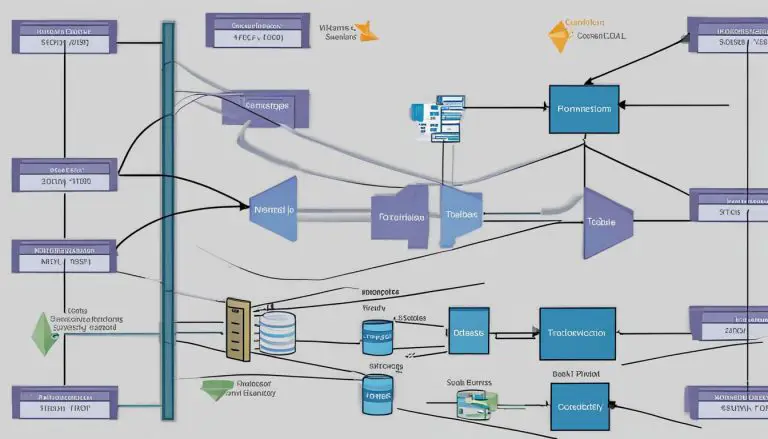What is ngx_http_rewrite_module ? In easy words
The ngx_http_rewrite_module is a powerful module in Nginx that allows for URL manipulation, request redirection, and conditional configurations. It is an essential tool for managing and controlling server behavior in Nginx. In this tutorial, I will guide you through the configuration, directives, syntax, and usage of the ngx_http_rewrite_module, providing examples and references to the documentation.
Key Takeaways:
- The ngx_http_rewrite_module is a module used in Nginx to change the request URI using PCRE regular expressions.
- It enables return redirects and the conditional selection of configurations.
- Directives such as break, if, return, rewrite, rewrite_log, set, and uninitialized_variable_warn are included in the module.
- The syntax and usage of the directives vary and can be used for condition evaluation, URL rewriting, and variable assignment.
- Examples of ngx_http_rewrite_module usage showcase its flexibility and power in managing URLs and server behavior.
Directives of ngx_http_rewrite_module
The ngx_http_rewrite_module module provides several directives that are essential for URL manipulation, request redirection, and conditional configurations. These directives allow for fine-grained control over the behavior of Nginx server.
Directives Overview
Below is a brief description of some commonly used directives of the ngx_http_rewrite_module:
- break: This directive stops processing the current set of ngx_http_rewrite_module directives, allowing you to exit the current iteration without executing further instructions.
- if: The if directive evaluates a specified condition and executes subsequent directives if the condition is true. It provides conditional branching in the configuration.
- return: The return directive stops processing and returns a specified code or URL to the client. It can be used for redirection or custom error handling.
- rewrite: The rewrite directive changes the request URI based on a specified regular expression. This allows you to modify the URL structure dynamically.
- rewrite_log: The rewrite_log directive enables or disables logging of ngx_http_rewrite_module directive processing results. It can be useful for debugging and troubleshooting.
- set: The set directive assigns a value to a specified variable. It is commonly used to create or modify variables for further use in the configuration.
- uninitialized_variable_warn: The uninitialized_variable_warn directive controls whether warnings about uninitialized variables are logged. It helps in detecting potential configuration issues.
Example
Here’s an example of how these directives can be used:
2
3
4
rewrite ^/old-url$ /new-url last;
return 301 https://$host$request_uri;
}In this example, if the request method is GET, the rewrite directive changes the URI of the request from /old-url to /new-url. The return directive then performs a permanent redirect to the modified URL using a 301 status code.
The image above highlights the various directives supported by the ngx_http_rewrite_module and their functionality.
Syntax and Usage of Directives
In the ngx_http_rewrite_module, each directive has its own unique syntax. Let’s explore the usage of some important directives:
if Directive
The if directive allows you to evaluate conditions, such as variable comparisons, regular expression matches, and file existence checks. This directive executes subsequent directives if the specified condition is true. Here’s an example:
if ($variable == ‘value’) {
# Do something
}
return Directive
The return directive is used to stop processing further directives and return a specific code or URL to the client. It is commonly used for redirecting requests. Here’s an example:
return 301 https://example.com;
rewrite Directive
The rewrite directive is essential for manipulating the request URI. It uses regular expressions to match and change the request URI. Here’s an example:
rewrite ^/old-page/(.*)$ /new-page/$1 last;
set Directive
The set directive allows you to assign a value to a specified variable. It is particularly useful for creating dynamic configurations. Here’s an example:
set $cache “true”;
These are just a few examples of the directives available in the ngx_http_rewrite_module. Each directive has its own unique purpose and syntax, providing you with the flexibility to configure Nginx according to your needs. Now, let’s move on to examples that demonstrate the usage of these directives.
Examples of ngx_http_rewrite_module Usage
Here are some examples that demonstrate the usage of ngx_http_rewrite_module:
Example 1:
if ($slow) { limit_rate 10k; break; }
This example sets the limit rate to 10k if the variable $slow is true.
The ngx_http_rewrite_module provides powerful capabilities for manipulating URLs and configuring server behavior in Nginx. Let’s take a look at a practical example:
2
3
4
5
if ($args ~ "download=sample") {
return 301 http://example.com/sample_file.zip;
}
}
In this example, when a user requests a download with the query parameter
1 | download=sample |
, they will be redirected to http://example.com/sample_file.zip.
| Directive | Description | ||
|---|---|---|---|
|
Evaluates a condition and executes subsequent directives if the condition is true. | ||
|
Stops processing and returns a specified code or URL to the client. | ||
|
Changes the request URI based on a specified regular expression. | ||
|
Sets a value for a specified variable. |
Internal Implementation of ngx_http_rewrite_module
In order to understand how the ngx_http_rewrite_module works, it is important to explore its internal implementation. This section delves into the behind-the-scenes processes that occur during the configuration and request processing stages.
During the configuration stage, the ngx_http_rewrite_module directives are compiled into internal instructions. These instructions serve as a set of rules for modifying the request URI, performing redirects, and selecting configurations.
Once the configuration is complete, the compiled instructions are interpreted during the request processing stage. The module utilizes a simple virtual stack machine for execution, ensuring efficient and reliable performance.
These instructions are executed sequentially, following the specified order in the configuration file. This allows for precise control over the URL manipulation and server behavior defined by the directives.
By understanding the internal implementation of the ngx_http_rewrite_module, developers and administrators gain insight into the mechanics behind its powerful functionality.
Note: The image above visualizes the internal implementation of ngx_http_rewrite_module, showcasing the compilation and interpretation stages.
Internal Implementation Overview
| Stage | Description |
|---|---|
| Configuration Stage | Directives are compiled into internal instructions |
| Request Processing Stage | Compiled instructions are interpreted and executed |
| Execution Model | Utilizes a simple virtual stack machine |
| Execution Order | Instructions are executed sequentially as per configuration file order |
The table above provides an overview of the internal implementation of the ngx_http_rewrite_module. It highlights the key stages and the execution model utilized by the module, ensuring a comprehensive understanding of its functioning.
Nginx Rewrite Examples
One of the powerful features of the ngx_http_rewrite_module is the ability to rewrite request URIs using regular expressions. By leveraging the
1 | rewrite |
directive, you can modify URLs to fit your desired structure or redirect requests to specific locations.
Example 1: Rewriting Request URIs
Let’s consider a scenario where we want to rewrite a request URI that includes the path
1 | /data/ |
followed by the word
1 | geek/ |
and a word consisting of alphanumeric characters. We can achieve this using the following rewrite rule:
This rewrite rule uses regular expressions to match the request URI and extracts the matching segments using parentheses. It then rewrites the URI by replacing the
1 | /geek/ |
segment with
1 | /linux/ |
and appends
1 | .html |
to the end. The
1 | last |
flag indicates that further processing of rewrite rules should be stopped.
By using the ngx_http_rewrite_module in conjunction with regular expressions, you have extensive control over the rewriting of request URIs in Nginx. This allows you to customize your URLs and redirect requests to the appropriate locations within your server configuration.
Error Handling and Logging in ngx_http_rewrite_module
Error handling and logging play a crucial role in the effective utilization of the ngx_http_rewrite_module. By carefully monitoring for errors and capturing relevant information, you can ensure the smooth functioning of your nginx server and quickly address any issues that may arise.
Error Handling
When working with ngx_http_rewrite_module, it is essential to check return codes and handle errors appropriately. One way to accomplish this is by utilizing the
1 | ngx_log_error() |
function. This function allows you to log errors or warnings, providing valuable insights into potential problems within your configuration.
To further assist in error handling, you can utilize the
1 | ngx_errno |
and
1 | ngx_socket_errno |
macros. These macros retrieve system and socket error codes, respectively. By incorporating them into your error handling strategy, you can gain more granular insights into the underlying causes of errors.
Logging
Logging is another critical aspect of ngx_http_rewrite_module. By enabling logging, you can gain visibility into the processing results of the module’s directives. To enable logging, you can make use of the
1 | rewrite_log |
directive, which allows you to control the logging behavior.
The logging information provided by ngx_http_rewrite_module is invaluable when it comes to debugging and troubleshooting. Reviewing the logs gives you a clearer understanding of the sequence and outcomes of the rewrite module’s execution, enabling you to identify and resolve any issues that may occur.

As you work with ngx_http_rewrite_module, be sure to incorporate robust error handling practices and enable logging to maximize the module’s efficiency and effectiveness.
| Error Handling | Logging |
|---|---|
| Check return codes | Enable logging using the rewrite_log directive |
| Utilize ngx_log_error() function for error and warning logging | Review logs for insights into rewrite module execution |
| Retrieve system and socket error codes using ngx_errno and ngx_socket_errno macros |
Conclusion
In summary, the ngx_http_rewrite_module is a powerful module in Nginx that enables effective URL manipulation, request redirection, and conditional configurations. It plays a crucial role in managing and controlling server behavior, making it an indispensable tool for Nginx administrators and developers.
With its wide range of flexible directives, the ngx_http_rewrite_module provides extensive control over URL rewriting and server behavior. Whether it’s changing the request URI using PCRE regular expressions, performing return redirects, or applying conditional configurations, this module empowers users to tailor their server’s behavior to meet specific requirements. By leveraging the various directives available, administrators can achieve precise control over how requests are handled and responses are served.
The usage examples provided demonstrate the versatility of the ngx_http_rewrite_module. These examples showcase how different directives can be combined to achieve specific outcomes, such as dynamically altering the URL structure or implementing conditional configurations based on request attributes. By understanding the syntax and effectively utilizing these directives, administrators can optimize their Nginx configuration to enhance website performance, improve SEO, and deliver a seamless user experience.
In conclusion, the ngx_http_rewrite_module is a valuable asset for Nginx users seeking to efficiently manage URLs, control server behavior, and optimize website performance. Its rich feature set, comprehensive documentation, and extensive community support make it an essential tool for anyone working with Nginx. By harnessing the power of the ngx_http_rewrite_module, administrators can elevate their Nginx configuration to new heights of flexibility and efficiency.
FAQ
What is the ngx_http_rewrite_module?
The ngx_http_rewrite_module is a module used in Nginx to change the request URI using PCRE regular expressions, perform return redirects, and conditionally select configurations. It is an essential tool for managing URLs and server behavior in Nginx.
What directives are included in the ngx_http_rewrite_module?
The ngx_http_rewrite_module includes directives such as break, if, return, rewrite, rewrite_log, set, and uninitialized_variable_warn.
What does the break directive do?
The break directive stops processing the current set of ngx_http_rewrite_module directives.
What does the if directive do?
The if directive evaluates a specified condition and executes subsequent directives if the condition is true.
What does the return directive do?
The return directive stops processing and returns a specified code or URL to the client.
What does the rewrite directive do?
The rewrite directive changes the request URI based on a specified regular expression.
What does the rewrite_log directive do?
The rewrite_log directive enables or disables logging of ngx_http_rewrite_module directives processing results.
What does the set directive do?
The set directive sets a value for a specified variable.
What does the uninitialized_variable_warn directive do?
The uninitialized_variable_warn directive controls whether warnings about uninitialized variables are logged.
What is the syntax for the ngx_http_rewrite_module directives?
The syntax for the ngx_http_rewrite_module directives varies for each directive.
What can the if directive be used for?
The if directive can be used to evaluate conditions such as variable comparisons, regular expression matches, file existence checks, and more.
What can the return directive be used for?
The return directive can be used to stop processing and return a specific code or URL to the client.
What can the rewrite directive be used for?
The rewrite directive uses regular expressions to match and change the request URI.
What can the set directive be used for?
The set directive assigns a value to a specified variable.
Can you provide an example usage of the ngx_http_rewrite_module?
Example 1: if ($slow) { limit_rate 10k; break; } – This example sets the limit rate to 10k if the variable $slow is true.
How are the ngx_http_rewrite_module directives processed?
The ngx_http_rewrite_module directives are compiled into internal instructions during the configuration stage. The compiled instructions are then interpreted during request processing.
How is error handling done in the ngx_http_rewrite_module?
Error handling in ngx_http_rewrite_module involves checking return codes and logging errors or warnings using the ngx_log_error() function. The ngx_errno and ngx_socket_errno macros can be used to retrieve system and socket error codes.
Can logging be enabled for the ngx_http_rewrite_module?
Logging can be enabled for the ngx_http_rewrite_module using the rewrite_log directive.
Source Links
- About the Author
- Latest Posts
Janina is a technical editor at Text-Center.com and loves to write about computer technology and latest trends in information technology. She also works for Biteno.com.






